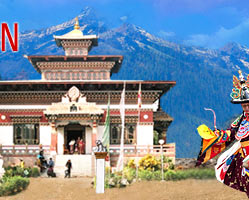The ancient Ta-Dzong building is more than 340 years old and used to serve as watchtower and fortress to protect main Paro Dzong. It was built by Tenzin Drungdra, the first Penlop (Governor) of Paro and the Second Desi (Regent) of Bhutan who ruled from 1656 to 1667. Tenzin was the half-brother of Shabdrung Ngawang Namgyal and was born in Trongsa Mangde. Ta Dzong is an unusual, round and seven storeys. Its walls are 2.5 m thick. Much later, in 1872, Jigme Namgyal sent Prince Ugyen Wangchuck (who later became the first hereditary monarch of Bhutan) to suppress the revolt of Tshewang Norbhu and capture Paro Dzong, which he did successfully. Later a plot was hatched to assassinate the young prince in this dzong but Jigme Namgyal discovered the plot in time and life of the prince. However, due to lack of proper maintenance, this historical watchtower was in ruins in the 1950s, until it was renovated to be used as the museum.
There are different galleries in the National Museum of Bhutan for better display and categorization of specimens such as the galleries for arms and armor, anthropology, bronzes, pre-history and early history of Bhutan, decorative arts, manuscripts, paintings, philatelic items, textiles, numismatics and epigraphic items. Some of the most popular galleries of National Museum of Bhutan are:
- Arms and Armor: The highlights here are the long matchlock gun known as tshanda, spears, canons, Rhino hide-shield, fish-scale helmets and indigenous arms that were used during in the 15th century war between the Bhutanese and the Tibetans and 19th century Duars war.
- Bhutanese Textiles: The exhibits provide a glimpse of rich Bhutanese textile tradition, the skill of the Bhutanese weavers through the ages and finest cotton, silk and wool textiles from all over Bhutan. It also shows the evolution of Bhutanese national dresses – gho and kira, monk's dresses and religious costumes.
- Bronze Gallery: Finest bronze, ivory, wood and iron exhibits can be seen here.
- Decorative Arts: The exhibits belonging to the 17th century are displayed here including masterpieces such as some of the finest copper teapots with metal inlays and exquisite geometric patterns.
- Epigraphic & Numismatic Items: There are stone inscriptions found here such as inscribed footprints on rock that tell much about Bhutanese history and culture. Numistatic history of Bhutan can be seen as early coins and more contemporary gold and silver coins.
- Evolution of the Bhutanese Script: Besides a chart relating the story of the evolution of Bhutanese script, you will come to know about ‘jogyig’, the Bhutanese cursive way of writing, here.
- Gallery on the 18th and 19th centuries: The highlights here are the Stem Cup of the First Desi Umze Tenzin Drugyal and Ugyen Wanhchuk’s (the first King of Bhtuan) pair of arrows.
- Gallery on the Shabdrung Era: It displays the seal of Nga Chudrugma, Thangkas and photographs of dzongs related to Shabdrung’s life, works and lineage. Shabdrung unified Bhutan in the 17th century AD.
- Jewellery: Covering 17th to 20th century, the star exhibits here are brooches (thingkhab), amulets (ga'u) and earrings.
- Manuscript Gallery: Collection includes rare manuscripts such as the ‘Prajnaparamita’ text (literally translated as ‘Transcendental Wisdom’) written in golden letters.
- Natural History: School children love this gallery as you can see varied fauna species of Bhutan here including birds, butterflies such as Bhutan glory, the snow leopard, takin and crocodile.
- Thangka Art: It displays selected thangkas covering a period of 17th century to 20th century. The art style reflected in these thangka paintings is the typical Bhutanese mix of Menlung and Gongkar Khentse traditions. The gallery is divide into three sections:
- Origin of Buddhism in India by eight masters,
- Development of Buddhism in Bhutan, and
- Main protective and tutelary deities of the country.
- Tribal/Nomads of Merag Sakteng: See traditional dresses, apparels, ornaments and other personal adornments of Merag Sakteng nomads, here.
- Water Clock: This ancient water clock attracts attention and interest of most of the visitors. This is the unique instrument that led to the coining of the Bhutanese terminology for wristwatch, ‘chusang khorlo’, which literally means ‘water measurement mechanism’.
Bhutan’s National Museum in Ta Dzong at Paro remains closed on Mondays and government holidays. It opens from 9:00 am to 4:00 pm from Tuesday to Saturday and 11:00 am to 4:00 pm on Sundays. The admissions in the museum are allowed only up to 3:30 pm. There are special facilities provided by the museum too such as free guided tours of galleries for special guests, gallery talks on specific topics related to the respective galleries and talks and lectures for students visiting the museum on Bhutanese history, culture and related subjects.




